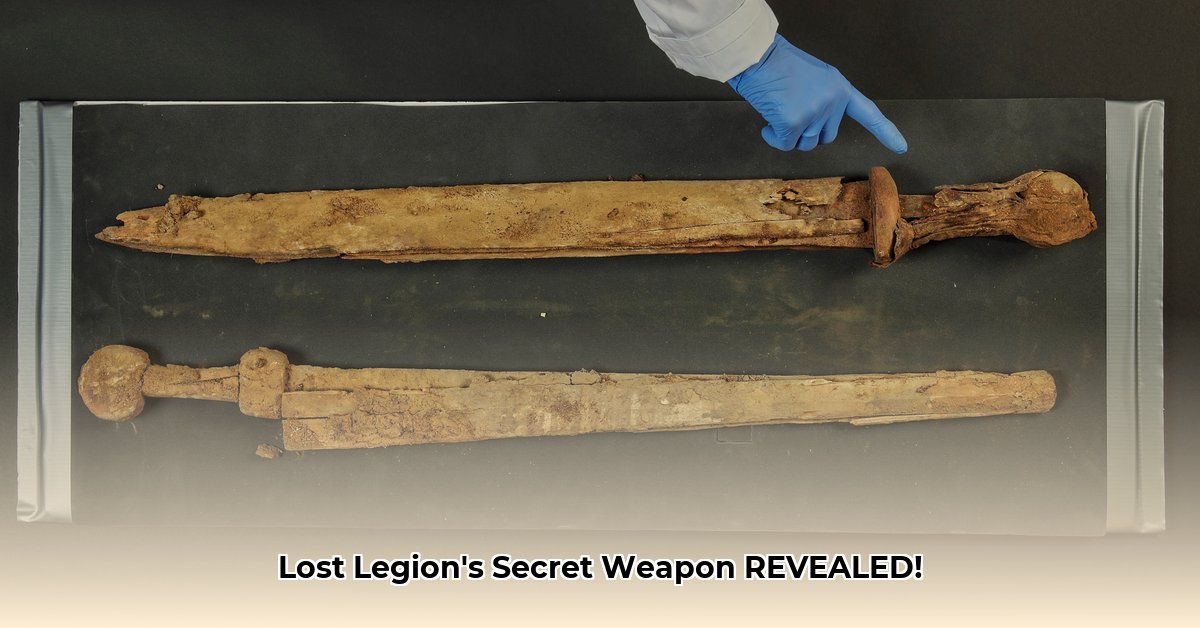When imagining the formidable Roman soldier, a common perception calls forth the short, thrusting gladius. Yet, a longer, more versatile blade, the ancient Roman spatha, commands a pivotal, though often underappreciated, chapter in military history. This powerful sword’s journey, revealed through archaeological discoveries and historical texts, unveils an intriguing narrative. It explores the spatha’s mysterious origins, its transformative development, and how it fundamentally reshaped Roman combat strategies. Looking at related equipment? Learn more about Roman armor. Beyond dusty archives, a deeper dive offers concrete details on its construction, its tactical advantages over shorter swords, and its enduring legacy that resonates through centuries of weapon design. By dissecting historical perceptions, we can explore how this remarkable weapon truly changed the game, providing a fresh perspective on Roman military innovation and its profound impact on subsequent European armaments.
Ancient Roman Spatha: Unveiling a Legion’s Tactical Shift
The narrative of the ancient Roman spatha is far more than a simple account of a weapon; it’s a compelling illustration of the Roman army’s continuous adaptation in the face of evolving adversaries and expanding territories. This straight, long sword, typically measuring between 20 and 40 inches (approximately 50 to 100 cm) with a handle length of between 7 and 8 inches (18 to 20 cm), was initially favored by Celtic warriors, particularly cavalry. Its eventual adoption as a standard infantry weapon by the Romans represents a significant military transformation. But what pivotal factors instigated this profound shift in Roman armaments and battlefield doctrine, compelling them to abandon their long-standing preference for the gladius? Let’s explore the intricate evolution of this formidable blade.
Why the Gladius Took a Backseat
For centuries, the Roman legions had relied almost exclusively on the gladius, a short, double-edged sword perfectly suited for close-quarters combat within tight formations. Typical gladii ranged from 14 to 24 inches (36 to 60 cm) in blade length. This design excelled at thrusting maneuvers behind the protective large rectangular scutum (shield) in compact units, where a legionary could deliver precise, powerful thrusts in the narrow gaps between shields. So, why did they embrace the spatha? The ancient Roman spatha offered superior reach and enhanced versatility, allowing for effective slashing and stabbing, making it a more adaptable tool for a broader spectrum of combat scenarios. As the Roman Empire expanded into Northern Europe, encountering diverse fighting styles across open battlefields and dense forests, the limitations of the gladius became apparent. Its shorter length proved less effective against enemies who employed longer weapons or different fencing techniques, highlighting a crucial need for a blade that could offer a reach advantage.
From Mounted Warriors to Foot Soldiers: A Military Evolution
The initial adoption of the ancient Roman spatha by cavalry units was a pragmatic decision; a longer blade provided a distinct advantage for striking enemies from horseback, allowing horsemen to deliver decisive blows while maintaining distance. These early spathae often featured a rounded tip to prevent accidental injury to the cavalryman’s own foot or horse during mounted combat. Historically, Celtic mercenaries introduced the spatha to the Roman army as early as the Second Punic War, bringing their longer swords into Roman service. Yet, over time, a significant transformation occurred: Roman infantry units progressively incorporated the spatha, eventually replacing the gladius entirely by the late 2nd to 3rd century AD. This shift signals a fundamental alteration in Roman military tactics and equipment. The Roman expansion into Northern European territories, characterized by varied terrain and unfamiliar enemy combat methods, notably those of Germanic and Sarmatian barbarian tribes, accounted for this strategic pivot. This change showcased Rome’s remarkable capacity for military innovation, adapting its weaponry to diverse combat environments.
The Spatha’s Northern Reach and Battlefield Dominance
The ancient Roman spatha’s extended reach bestowed a significant tactical advantage upon Roman soldiers, especially when confronting adversaries employing different combat methods. The increased blade length, coupled with the ability for both stabbing and cutting, allowed individual soldiers greater flexibility. This versatility became increasingly beneficial, potentially leading to the gradual abandonment of the deep, tight formations that necessitated the scutum (large shield), as soldiers could now fight more effectively in looser arrays. Infantry soldiers, who often stood with their left foot forward, a shield in their left hand, and their weapon in their right, found the spatha’s reach immensely beneficial, allowing them to fight more conservatively and maintain a superior engagement distance. The spatha’s design also allowed for variations that supported two-handed grip techniques, further maximizing its versatility against different types of opponents on the battlefield.
Echoes from the Past: Archaeological Confirmations
Archaeological excavations across regions like Britain, Germany, and Denmark unequivocally confirm the widespread deployment of the ancient Roman spatha throughout the vast Roman Empire and its sphere of influence. A notable example is the cache of 90 spathae discovered at Nydam Mose in Denmark in 1858, which are dated to the 3rd to 4th centuries AD. Its innovative design even cast a long shadow, profoundly influencing the development of later European swords, including those famously wielded by the Vikings. Despite its undeniable impact, the precise origins of the spatha remain a subject of scholarly debate. Some historians contend it evolved directly from Celtic longswords, while others argue for an independent Roman development. Nevertheless, its influence on subsequent weapon design is indisputable. Intriguingly, the very word “spatha” derives from the Latin spatha, which itself comes from the Greek term σπάθη (spáthē), simply meaning “any broad blade, of wood or metal.” This linguistic legacy is further cemented by the fact that the Byzantine court preserved the title “spatharios” for its esteemed sword-bearers, cementing the enduring legacy of this Roman weapon.
Ein Gedi Discovery: A Late Imperial Snapshot
The remarkable discovery of several spathae, including two of the Pompeii type and one possibly of the Fontillet type, in a cave near Ein Gedi, Israel, artifacts dated to the Bar Kokhba revolt (132–136 CE), further underscores the ancient Roman spatha’s continued relevance in later conflicts. These swords were likely hidden by Jewish rebels who had taken them as booty, possibly for their own use, highlighting the weapon’s widespread effectiveness and popularity even beyond the legions themselves. This discovery provides tangible evidence of the spatha’s presence and utility in diverse regions of the Roman Empire during the Imperial period.
Pivotal Insights from the Spatha’s Story:
The ancient Roman spatha offers profound insights into the remarkable adaptability of Roman military forces. For modern scholars, unearthing its history provides actionable pathways for understanding ancient warfare:
- Deciphering Roman Military Strategy: The spatha’s adoption reveals a shift from reliance on close-quarters thrusting to a more versatile approach encompassing both cutting and thrusting—a crucial adaptation for facing diverse enemy formations and terrains that required greater reach and flexibility.
- Analyzing Cultural Interaction: The debated origins (Celtic vs. Roman) and the sword’s widespread influence on Germanic and Viking blades highlight the deep and complex cultural exchange inherent in ancient military development, demonstrating how Roman innovations could be absorbed and re-interpreted by other cultures.
- Understanding Weapon Technology: The spatha’s design, including elements like the fuller (a groove running down the blade designed to lighten it without compromising strength) and the increasing use of pattern welding (a sophisticated forging technique combining different steels for strength and appearance), demonstrates advanced metallurgical understanding and its application in creating more effective battlefield tools, pushing the boundaries of ancient craftsmanship.
| Feature | Gladius | Spatha |
|---|---|---|
| Typical Length | ~14-24 inches (36-60 cm) | ~20-40 inches (50-100 cm) |
| Primary Use | Thrusting, close-quarters combat | Slashing, cutting, versatile combat |
| Historical Period | Roman Republic & Early Roman Empire | Late Roman Empire & Migration Period |
| Infantry Use | Primary weapon for legionaries | Gradually replaced gladius as primary infantry weapon |
| Cavalry Use | Less common, often inconvenient | Primary weapon for cavalry |
| Origin | Iberian Peninsula | Likely Celtic, later adopted by, or evolved within, Roman military |
How the Spatha Influenced Early Medieval Swords
The ancient Roman spatha’s profound impact extended far beyond the imperial borders, critically shaping the development of early medieval weaponry. Did this Roman blade genuinely inform and influence the iconic swords of the early Germanic tribes and Norsemen? The evidence strongly suggests a compelling connection, revealing a fascinating narrative of cross-cultural technological transfer and adaptation across centuries.
Spatha: From Cavalry to Infantry Dominance
Initially, the spatha, significantly longer than the gladius, was the weapon of choice for Roman cavalry. What made it so indispensable for mounted combat? Its extended reach allowed horsemen to deliver decisive blows from horseback, particularly through downward swings, which were easier to execute and reduced the chance of dropping the weapon compared to thrusting in tight spaces. Yet, over centuries, an intriguing transformation occurred: Roman infantry units progressively adopted the spatha. This shift wasn’t arbitrary; the Roman army was in a continuous state of evolution, and the spatha’s superior versatility, capable of both thrusting and cutting, proved invaluable in the dynamic landscape of changing military tactics. By the 3rd century AD, it ultimately superseded the gladius as the standard infantry sword, with legionaries and cavalrymen alike beginning to wear their swords on the left side, perhaps due to the abandonment of the scutum and the spatha’s longer length. Its remarkable adaptability was the crucial factor in its enduring influence, paving the way for future sword designs.
Design and Construction: A Blade’s Blueprint
The spatha was far more than a simple piece of metal; its creation involved sophisticated metallurgical techniques. Early pattern welding, for instance, a process of forging together different types of steel, was frequently employed to enhance the blade’s strength, resilience, and even its aesthetic appeal through contrasting metals and inlay. Archaeological findings reveal distinct design variations, with cavalry versions often featuring a rounded tip compared to the long point of infantry models. The blade itself often incorporated one or two forged fullers—distinctive grooves running down the length of the blade—which were crucial for reducing the sword’s weight without compromising its structural integrity. Such technical details from archaeological discoveries across Britain, Germany, and Denmark provide invaluable insights into its widespread adoption and evolutionary trajectory. Historical records also suggest Romans even altered the side on which they wore their swords, alongside adopting innovative baldrics (shoulder straps) for easier carriage of the longer blade.
The Perennial Question: Unraveling Origins
The precise origin of the ancient Roman spatha continues to be a hotly debated topic among historians and archaeologists. Was it definitively Celtic in origin, subsequently adopted and adapted by the Romans, perhaps introduced by Celtic mercenaries during the Second Punic War? Or did it emerge through a direct evolutionary process from the Roman gladius itself? While some historical sources hint at Celtic influence, others, like Tacitus, only mention its use by auxiliaries in encounters, without specifying their origin or whether they were cavalry. The lack of a Germanic name for the spatha further complicates the notion of a direct Germanic origin, despite its extensive use by Germanic warriors and the abundance of spathae found in Germanic territories. This ongoing academic discourse fuels continuous research and scholarly discussion. Perhaps future archaeological discoveries, coupled with advanced scientific analysis of extant artifacts, will finally illuminate the definitive origins of this enduring mystery, clarifying the intricate web of influences.
How the Spatha Influenced Viking Swords
So, how the spatha influenced Viking swords and other early medieval blades? The spatha’s impact resonated far beyond the geographical and temporal boundaries of the Roman Empire. As Germanic tribes interacted extensively with the Romans, they progressively adopted and skillfully adapted the spatha’s fundamental design principles. These early Germanic Iron Age swords, with blades typically measuring 28 to 32 inches (71 to 81 cm) in length and 1.75 to 2.375 inches (43 to 61 mm) in width, often featured very little taper and rounded tips. These, in turn, served as direct antecedents, significantly influencing the subsequent development of Viking Age swords. Viking blades took on a much more acute distal taper and point, featured deep fullers running their length, and sported unique pommel shapes (often flat at the grip side and roughly triangular, later curving to fit the hand). These similarities—the characteristic length, the straight, double-edged blade, and the pronounced emphasis on cutting effectiveness—all represent clear echoes of the spatha’s design philosophy. Through types classified by scholars like Jan Petersen (A–Z) and R. E. M. Wheeler (I–IX), we see a direct lineage. While certainly not a direct, unoriginal replication, this represents a compelling example of profound cross-cultural inspiration spanning centuries and diverse martial traditions.
Spatha’s Enduring Linguistic and Martial Legacy
The spatha’s profound impact is not merely confined to the realm of weaponry; its very name lives on, woven into the fabric of European languages. The Latin term spatha serves as the linguistic root for “sword” in numerous Romance languages, including the French épée, Catalan and Occitan espasa, Portuguese and Spanish espada, Italian spada, Romanian spadă, and Albanian shpata. This linguistic lineage stands as a compelling testament to the sword’s immense significance within Roman society and its lasting cultural influence across Europe. The term also gave rise to Byzantine court titles like spatharios (“bearer of the spatha”), protospatharios, and spatharokandidatos, further cementing its historical importance. From shaping battlefield tactics to embedding itself in our vocabulary and honorifics, the spatha’s indelible mark is unequivocally undeniable.
| Feature | Spatha (Roman) | Viking Sword | Knightly Sword (High Middle Ages) |
|---|---|---|---|
| Blade Length | Typically 60-100 cm (24-40 inches) | Typically 70-90 cm (28-35 inches) | Typically 80-100 cm (31-39 inches) |
| Blade Shape | Straight, double-edged, varying taper | Straight, double-edged, acute distal taper | Straight, double-edged, less taper than Viking |
| Primary Use | Cutting and thrusting | Primarily cutting, some thrusting |










